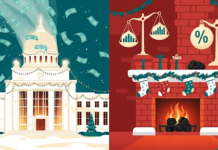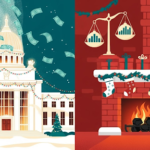Since 2020, we have all felt the impact of inflation in our lives. We’ve felt the rising costs of gasoline, eggs, meat, rent and other daily necessities.
Interest rate hikes, designed to cool down runaway inflation. Whle interest rates surged from under 3% to 6.5%, new 30-day mortgage interest rates doubled, pushing the cost of housing out of reach for many Americans.
The graphic below clearly illustrates the inverse relationship between rising interest rates and existing home sales.
Image Source: Visual Capitalist
Over the past several years, inflation jumped from a low of 1.25% in 2020 to a high of 8% in 2022. There’s no doubt that the past three years have been painful, but the curve of rising prices seems to be abating.
Gas prices peaked in 2022 at near $5 per gallon. Since then, the national U.S. retail price has come back down to $3.25, returning to levels not seen since 2020.
Source: U.S. Energy Information Administration.
Most recently, Fed chairman Jerome Powell remarked in the December 13 FOMC statement that the stage was set for up to 3 potential interest cuts in 2024. Some project that annual inflation wil return to levels around 2.1% in the years to come, down from the current level of 4.5%
Projected Annual Inflation Rate in the U.S. from 2010 – 2028 (Source: Statista)
What Caused the Spike in inflation from 1.25% to 8%?
The rise of inflation to 7% in 2021 can be attributed to a combination of several key factors. While the specific drivers of inflation can vary by country and region, here are some of the common factors that contributed to the increase in inflation during that period:
- Supply Chain Disruptions: The COVID-19 pandemic disrupted global supply chains, causing shortages of goods and raw materials. This led to supply constraints and higher production costs, which in turn drove up prices for a wide range of products.
- Increased Demand: As economies began to recover from the pandemic, there was a surge in demand for goods and services. This increase in consumer and business spending put upward pressure on prices, particularly in sectors like housing, automobiles, and consumer electronics.
- Fiscal Stimulus: Many governments around the world implemented significant fiscal stimulus measures to support their economies during the pandemic. These measures included direct payments to individuals, expanded unemployment benefits, and business support programs. The injection of money into the economy boosted demand, contributing to inflationary pressures.
- Monetary Policy: Central banks in some countries kept interest rates at historically low levels and engaged in quantitative easing to stimulate economic growth. While these measures were essential to support the recovery, they also added to inflationary pressures by increasing the money supply.
- Rising Commodity Prices: Prices of commodities, such as oil, metals, and agricultural products, experienced significant fluctuations in 2021. Supply disruptions, extreme weather events, and increased demand for raw materials from the recovery efforts all played a role in driving up commodity prices.
- Labor Market Dynamics: Labor shortages and wage pressures were observed in various industries, leading to higher labor costs. As businesses competed for workers, they often had to offer higher wages and benefits, which contributed to overall inflation.
- Base Effects: Inflation figures can be influenced by “base effects,” which occur when comparing current prices to unusually low prices from a previous period. In 2020, many prices fell due to the pandemic’s impact, making the year-over-year comparison in 2021 appear higher.
- Bottlenecks and Transportation Costs: Supply chain bottlenecks and rising transportation costs, including shipping container shortages and higher freight charges, contributed to increased production and distribution expenses, which were passed on to consumers in the form of higher prices.
It’s important to note that the specific factors and their relative contributions to inflation can vary by country and region. Central banks and policymakers closely monitor these factors and use various tools, such as adjusting interest rates and implementing fiscal policies, to manage and stabilize inflation rates.
With Inflation on its way down, what are the Key Stock Sectors to Watch?
Home sales can rebound when interest rates continue falling
When inflation is on its way down from high levels, it can have a significant impact on the stock market and various sectors. Investors tend to reassess their portfolios and consider sectors that may benefit from lower inflation and a potentially different economic environment. Here are some key stock market sectors to watch as inflation trends down from 8% to 4%:
- Technology: The technology sector often performs well in a low inflation environment. Tech companies tend to have strong earnings growth potential, and lower inflation can lead to lower interest rates, making future cash flows from tech stocks more valuable.
- Consumer Discretionary: As inflation decreases, consumers may have more disposable income, which can benefit companies in the consumer discretionary sector. This includes industries like retail, entertainment, and hospitality.
- Healthcare: Healthcare is typically less sensitive to inflation changes and can be a defensive sector. Companies in pharmaceuticals, biotechnology, and healthcare services may continue to perform well.
- Financials: Financial stocks, including banks and insurance companies, can benefit from lower inflation if it leads to lower interest rates. However, the performance of financials can also depend on broader economic conditions and the interest rate environment set by central banks.
- Industrials: Some industrial companies may benefit from decreased inflation, especially if it reduces input costs and improves profit margins. Infrastructure spending and manufacturing can also play a role in this sector’s performance.
- Utilities: Utilities are often considered a defensive sector and can perform well when inflation is lower. These companies typically offer stable dividends, which can be attractive to investors seeking income.
- Real Estate: Real estate investment trusts (REITs) may perform well in a lower inflation environment. Lower interest rates can make real estate investments more attractive, and lower inflation can reduce the cost of financing for property purchases.
- Materials: While materials stocks can be sensitive to inflation changes, they may still benefit from lower inflation if it leads to improved economic stability and demand for construction and manufacturing materials.
- Energy: The energy sector’s performance can be influenced by various factors, including changes in oil prices and global demand. It may not be as directly tied to inflation trends, but it’s essential to monitor the energy sector’s dynamics.
Conclusion
Falling annual inflation rates can play a crucial role in stimulating the economy and helping to restore normalcy for the average American.
As inflation decreases, the purchasing power of consumers tends to increase, allowing them to buy goods and services at more affordable prices. This, in turn, can boost consumer confidence and spending, which are vital drivers of economic growth.
Lower inflation also allows central banks to maintain accommodative monetary policies, such as lower interest rates, which can encourage borrowing, investment, and job creation.
Furthermore, decreased inflationary pressures can alleviate some of the financial burdens on households and businesses, leading to greater economic stability.
While the precise impact of inflation on the economy is multifaceted, a controlled decrease in annual inflation rates can contribute to a more favorable economic environment, benefiting the everyday lives of Americans and supporting broader economic recovery efforts.























